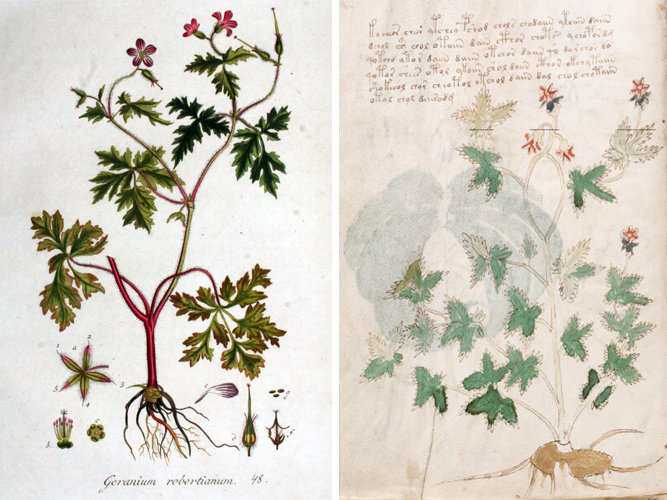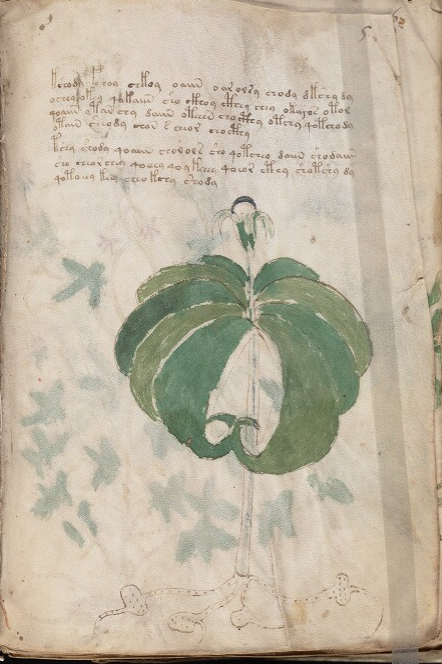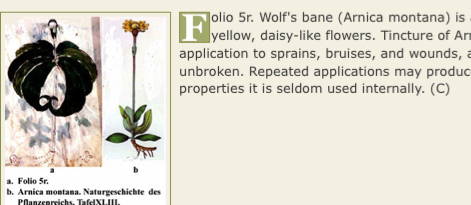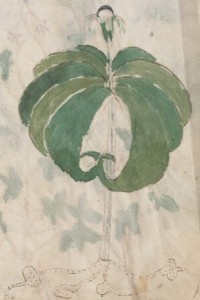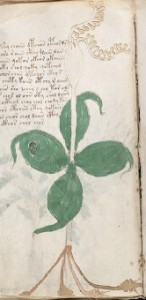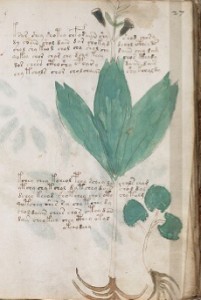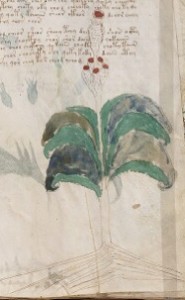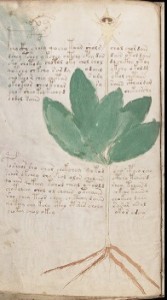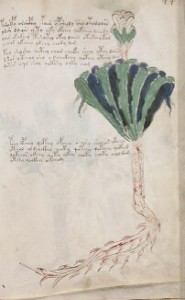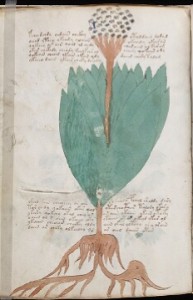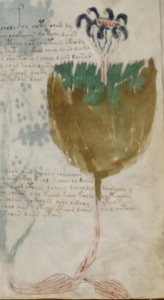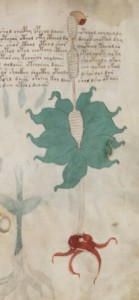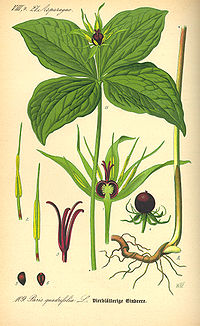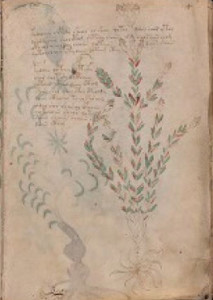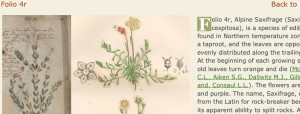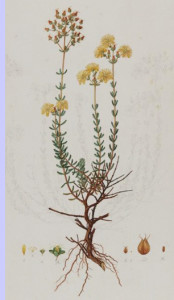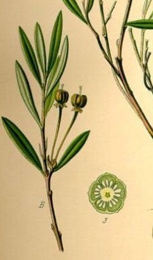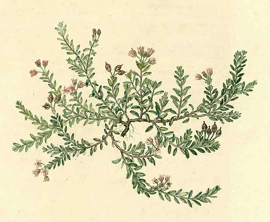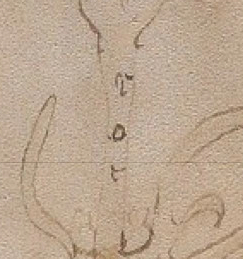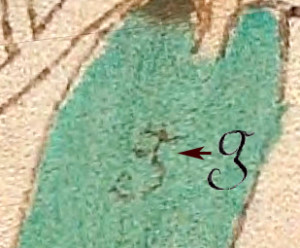Note: This is a re-upload of a blog I posted in July 2013 and removed soon after, along with a number of other large-plant articles, because I felt I was giving too much away (I thought I was close to finding a solution to the VMS—a common affliction among VMS researchers
). I have trimmed the images slightly, added a hyphen, and fixed a comma. Other than that, I have not altered the text in any way because my opinion about the identity of the plant hasn’t changed at all in the intervening time.
Plant 8r
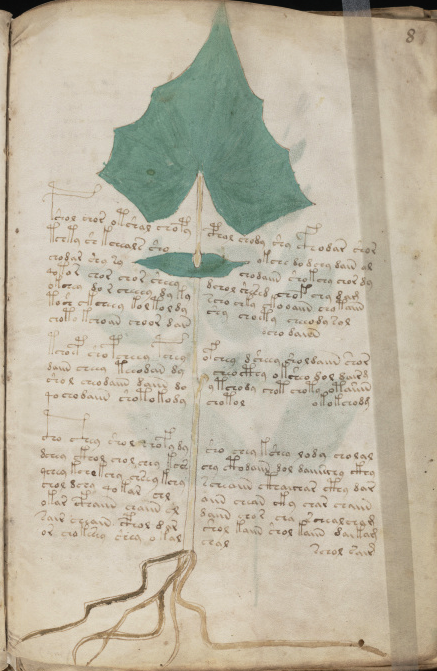 Plant 8r stands boldly upright, filling the middle of the page from top to bottom, with text flowing around it on either side. There is more text than on many big-plant pages, three moderately long paragraphs.
Plant 8r stands boldly upright, filling the middle of the page from top to bottom, with text flowing around it on either side. There is more text than on many big-plant pages, three moderately long paragraphs.
It has a slender erect stem, very slightly colored with a pale amber wash, a single spade-like leaf drawn erect and painted in quite a flat shade of medium green. There is something that resembles a smaller leaf or node just below it. Just above the node, the stem is slightly more bulbous, a feature that appears to be deliberate, rather than a slip of the pen.
The roots are long and spindly and colored medium-dark to light brown, spanning the width of the page.
There are a number of plants, both New and Old World that have spade-like leaves, some of which are quite erect. What is more difficult to interpret is the node-like green spot under the leaf. This is less common and might aid in identification, but it depends how one interprets it. Is it a leaf (clasping), a leafy node? Or something else?
Prior Identifications
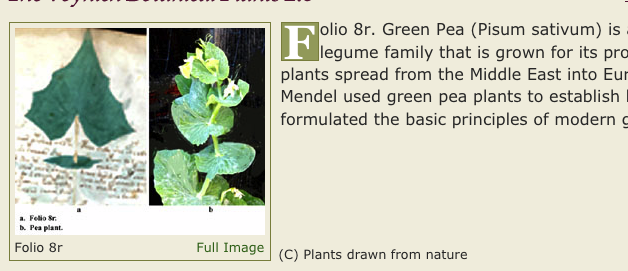 Edith Sherwood has identified this plant as green pea (Pisum sativum). I suppose this is reasonable if one interprets the green spot as a stem that goes through a rounded leaf, is in Pisum and some of the Lonicera species…
Edith Sherwood has identified this plant as green pea (Pisum sativum). I suppose this is reasonable if one interprets the green spot as a stem that goes through a rounded leaf, is in Pisum and some of the Lonicera species…
but, how does one explain the rest of the plant? P. sativum doesn’t have unpierced oversized spade-like leaves, and it’s not an upright plant (it’s a vine that uses tendrils to climb and has a somewhat staircased stem that goes in a different direction after each leaf, as you can see in Sherwood’s picture). Pisum is also distinct for its pods and this feature is absent from the VMS drawing (I’m not saying the VMS illustrator included every feature, but pea plants are almost universally drawn with pods by other medieval artists, or with several leaves in a viny formation and the VMS illustrator did take the time to draw a nub of broken stem and the slightly enlarged part of the stem above the green spot).
Without completely discounting Pisum, there are other plants that resemble Plant 8r more closely than Pisum that should probably be considered as better candidates.
Other Possibilities
One way you might explain the green spot under the leaf is as a reflection. If this is an aquatic plant, then a spot of green is often mirrored on the water just below the leaf, it looks like a little puddle of green. There are many plants that are terrestrial for part of the year and aquatic during seasonal floods. Other plants are primarily aquatic or semi-aquatic. If the green spot is mnemonic, this would be an easy way to remember this as an aquatic plant.
If it is, instead, something more literal, like a leaf or leaf-node, then it narrows down the number of plants that might qualify.
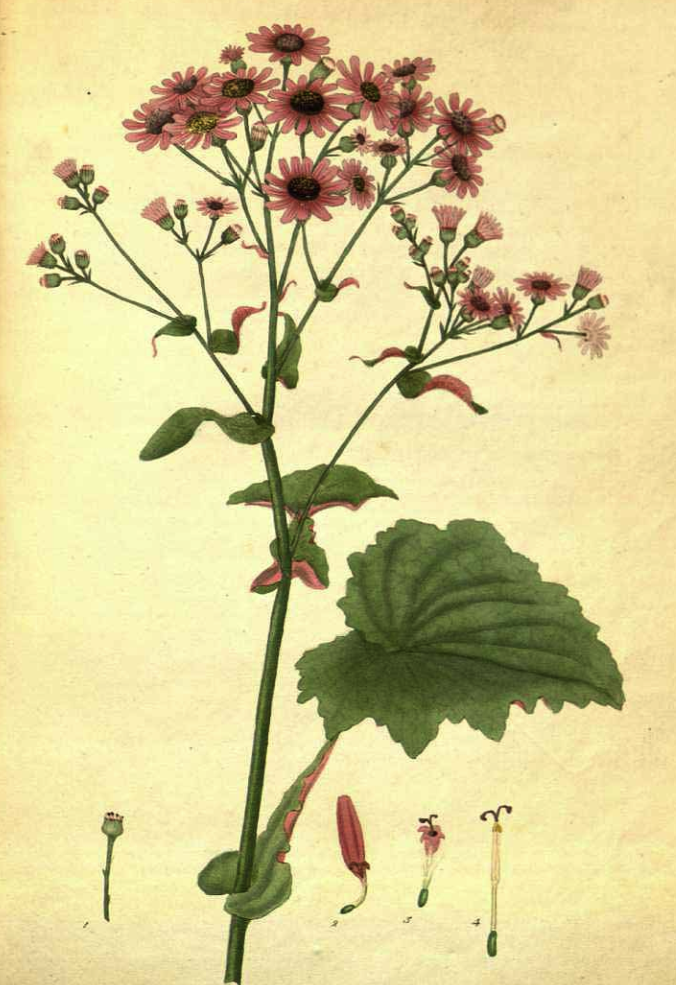 Pericaulis is an attractive plant with masses of blooms. Some species are fairly erect, while others have a more staircased look to the stems. But the “staircasing” is longer than that of Pisum and thus more similar to the VMS drawing. The leaves are not upright, but are shaped similarly to Plant 8r, a characteristic that is more noticeable in the spring before the buds and blooms start to appear.
Pericaulis is an attractive plant with masses of blooms. Some species are fairly erect, while others have a more staircased look to the stems. But the “staircasing” is longer than that of Pisum and thus more similar to the VMS drawing. The leaves are not upright, but are shaped similarly to Plant 8r, a characteristic that is more noticeable in the spring before the buds and blooms start to appear.
What is particularly interesting about Pericaulis is the way the leaves of some species attach to the stem. There is a large broad leaf, a narrow section, and then a rounded clasping part, as can be seen in the image to the right. This characteristic can be found on species growing in Madeira and the Canary Islands, islands off the coasts of Portugal and Spain.
I don’t think Pericaulis is the best candidate for the VMS plant, but I do think it might provide an explanation for the green splot that is under the leaf on the VMS plant. Perhaps VMS 8r is one of the plants that has a double-leaf shape in which the part between the two broader parts looks like a stem.
Colt’s Foot
 Tusilago farfara, also known as colt’s foot, is a distinctive plant found in many herbal manuscripts. It has leaves shaped similarly to the VMS and they are fairly upright. Where they attach to the stem, they widen into a rounded clasping shape, not quite like the VMS or like Pericaulis, but at least their orientation and shape match Plant 8r reasonably well.
Tusilago farfara, also known as colt’s foot, is a distinctive plant found in many herbal manuscripts. It has leaves shaped similarly to the VMS and they are fairly upright. Where they attach to the stem, they widen into a rounded clasping shape, not quite like the VMS or like Pericaulis, but at least their orientation and shape match Plant 8r reasonably well.
One often sees several leaves before the flower stalks appear and they are distinctive enough to identify the plant without the flowers.
T. farfara has long spindly rhizomes, sometimes drawn in the middle ages to look like a tap root, but more often drawn as long stringy roots with secondary roots. The picture on the left post-dates the VMS, but gives a good sense of the shape of the leaves and their erect posture.
Tussilago spuria has leaves similar to Tusilago farfara and Plant 8r, but the root is quite bulbous and the towering flower stalks set it apart from the more modest T. farfara. Given the difference in the roots, it’s probably not a good candidate for Plant 8r.
Tussilago petasites, now known as Petasites hybridus is somewhere in between T. farfara and T. spuria in terms of similarity to the VMS plant, and it’s a plant that is often submerged in fresh water, but the root tends to be thicker than that of T. farfara.
An interesting characteristic of T. farfara is that if you stand above the plant when the leaves are growing, before the flower stalks are visible, it looks like there is a backwards leaf-cup attached to the stem of the older fully formed leaves. This is because the old leaves fan out and the new leaves poke up in the center right next to them, making it look like the two are attached (very much like the VMS leaf). I don’t know if this might account for the way the VMS plant is drawn and I don’t know if it’s obvious enough to most observers to be relevant, but I thought it worth mentioning.
Indian Plantain
Arnoglossum atriplicifolium (a New World plant) might deserve a brief mention as it sometimes has spade-like leaves and tall slender light-brown stems, but the leaves can be variable, the points are closer together than the VMS leaf, and there are usually many leaves on one stem.
So the above plants have some commonalities with Plant 8r, but are they similar enough? Are there others that should be considered?
Let’s look at the Adenostyles.
Mountain Asters
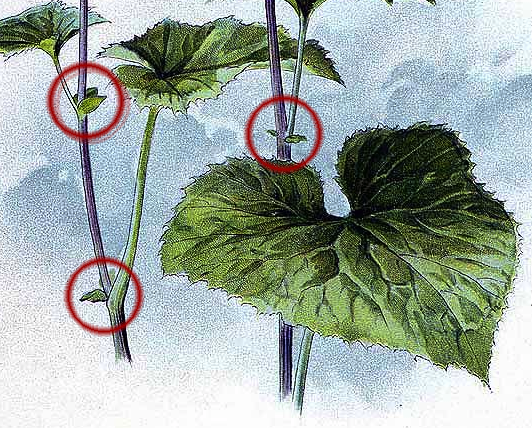 You may not have heard of them, but Adenostyles are upright plants that are widespread throughout continental Europe and west Asia. They are particularly prevalent in mountainous areas, growing in lush clumps in alpine meadows, often on rocky terrain.
You may not have heard of them, but Adenostyles are upright plants that are widespread throughout continental Europe and west Asia. They are particularly prevalent in mountainous areas, growing in lush clumps in alpine meadows, often on rocky terrain.
The leaves are somewhat variable, from rounded to more sharp or angular, but many of them are spade-like, like Plant 8r, and distinctive enough to recognize before the plants begin to flower.
 Those of particular interest are species with leaflets at each node where the leaf stalk connects to the stem (upper right), or those with a rounded enlargement at the point where the leaf connects to the stem (left).
Those of particular interest are species with leaflets at each node where the leaf stalk connects to the stem (upper right), or those with a rounded enlargement at the point where the leaf connects to the stem (left).
These kinds of plant structures may account for the green splot under the VMS leaf.
The leaf margins of Adenostyles are serrated (as are all the plants mentioned so far except Pisum and, to some extent, Tussilago farfara), but the serrations vary from one species to the next… some are deeply toothed, while others are so finely indented you almost don’t notice the serrations. I mention this because the VMS leaf is smooth in between the broader points—there’s no obvious indication that Plant 8r has serrated leaves.
Siberian Asters
There is a Siberian plant that somewhat resembles Petasites spurius called Ligularia sibirica. Like P. spurius, it has spade-like leaves and a tall flower spike. It is more delicate and slender, however, more similar to the VMS plant, and the place where the leaf connects to the stem is more rounded and clasping. Like the Adenostyles, it grows in lush clumps in sunny meadows. The leaf margin is not as distinctly angular as Plant 8v, so it might not be the best candidate.
Butterbur
Coming back to Petasites (which is one of the synonyms for Tussilago), there are some species that resemble the VMS plant more closely than those already mentioned.
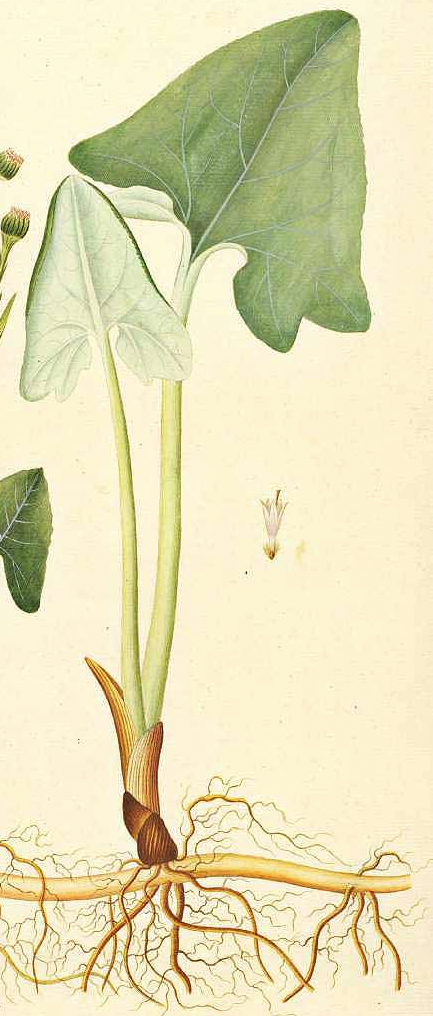 Petasites radiatus is of particular interest because it grows in wetlands and has tall slender stalks with a single leaf at the top, while older leaves of this species and others sit just below the surface of the water and are seen less distinctly (perhaps inspiring a green splot under the main VMS leaf?).
Petasites radiatus is of particular interest because it grows in wetlands and has tall slender stalks with a single leaf at the top, while older leaves of this species and others sit just below the surface of the water and are seen less distinctly (perhaps inspiring a green splot under the main VMS leaf?).
Often there will be broad patches of skinny stems sticking far up out of the water and no flowers at all. When the flowers do emerge, many are on separate stalks (Petasites spurius also has this characteristic—see illustration right).
The tall stalks are due to the shifting water levels on the edges of rivers or ponds. When the water level goes down, one sees a forest of tall spikes with green tops and the reflections of other leaves under the water. It’s quite an amusing sight.
As with many aquatic, or semi-aquatic plants, P. radiatus has long rhizomes (sideways-growing roots) and long spindly secondary roots, a reasonably good match to the VMS drawing.
I could definitely see an upright spindly plant like Petasites radiatus or P. spurius inspiring a drawing like Plant 8r.
J.K. Petersen
© Copyright 2013 J.K. Petersen, All Rights Reserved

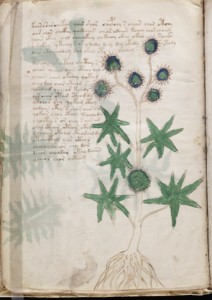
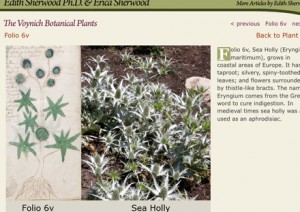
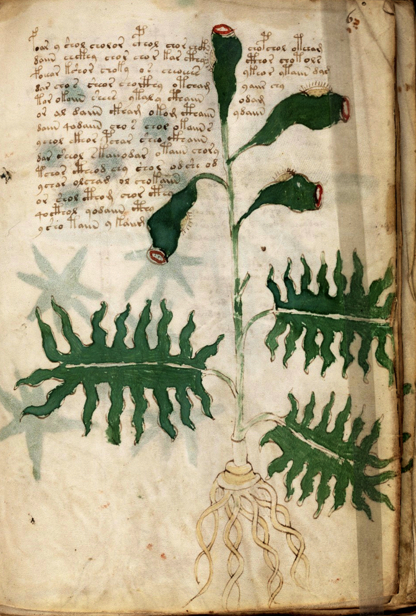 Description
Description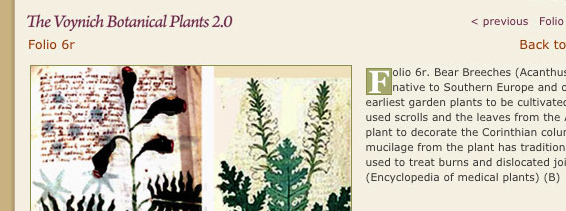
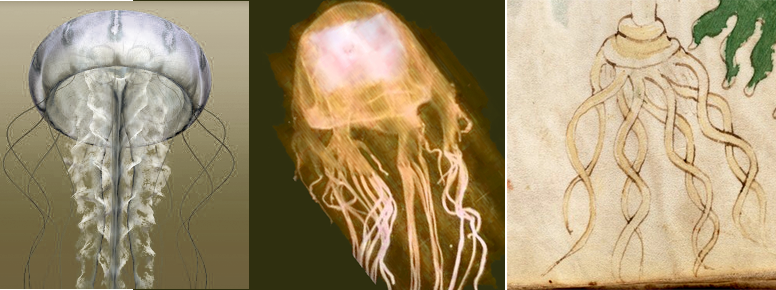
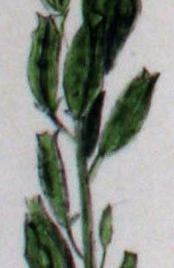
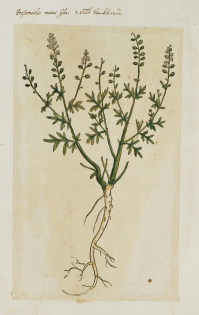
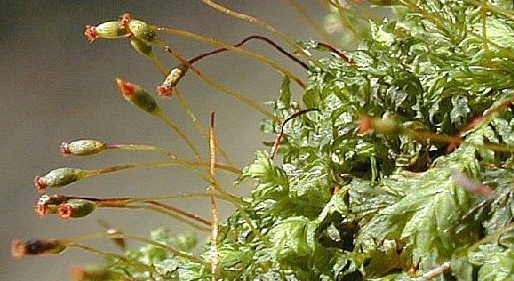
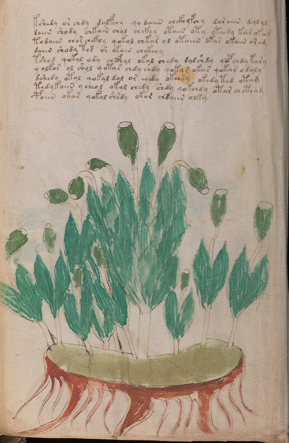
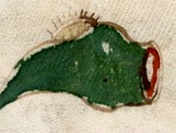
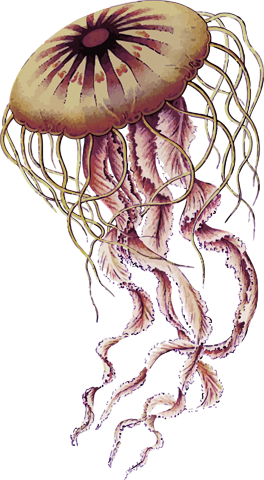
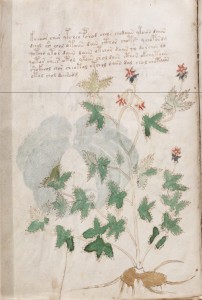
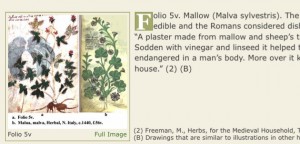
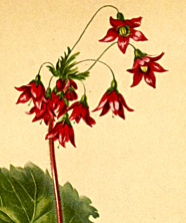
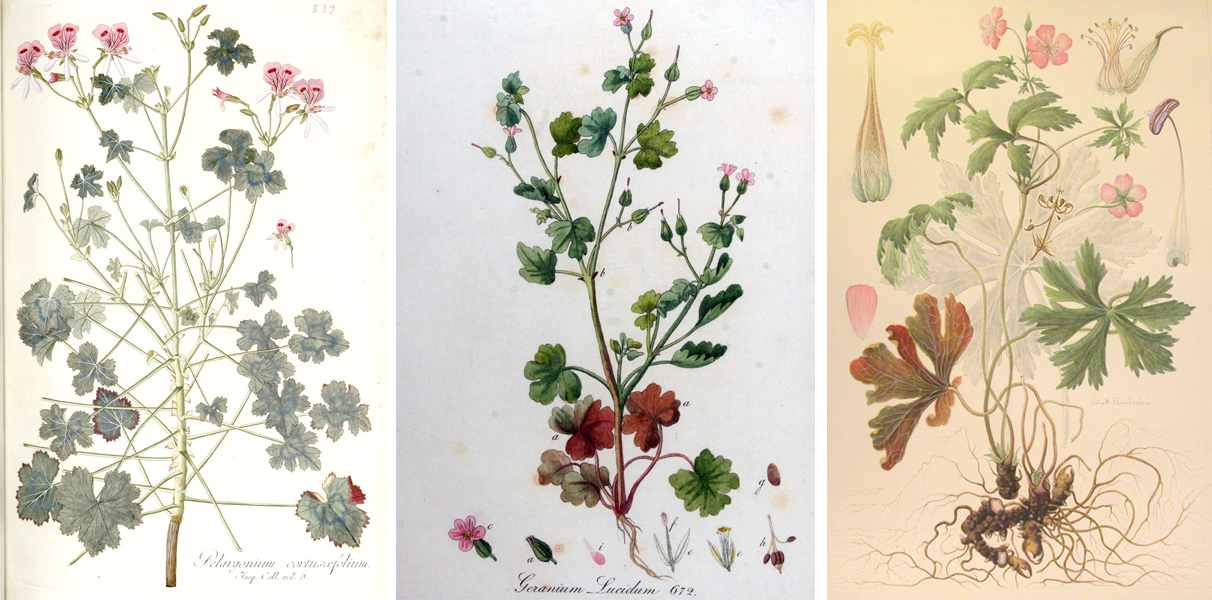
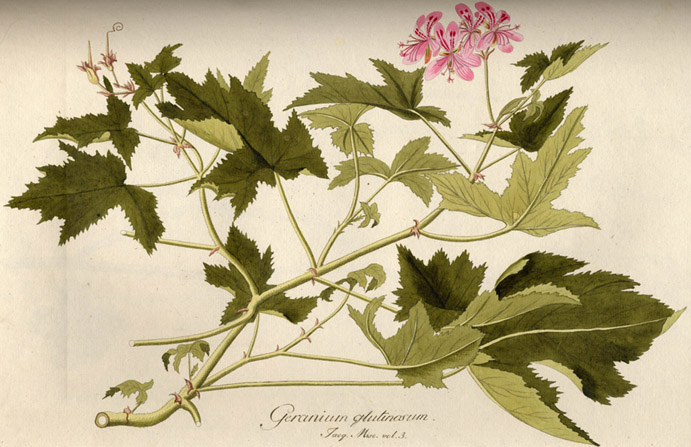 Geranium robertianum (a very widespread plant also known as herb Robert) was used medicinally in the early days, and is still used as a mosquito repellent:
Geranium robertianum (a very widespread plant also known as herb Robert) was used medicinally in the early days, and is still used as a mosquito repellent: